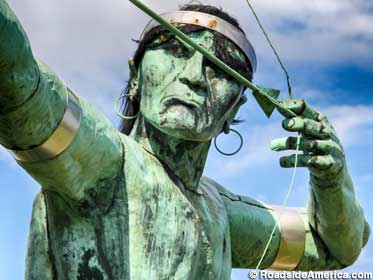First Americans
Related: About this forumEngraved medal given to Chief Kesis, a Kickapoo Indian chief of east central Illinois in 1792
I found this interesting account of a medal found in Danville Illinois given to Chief Kesis in 1792 by General Putnam.


PEACE MEDAL GIVEN AT THE TREATY OF VINCENNES, SEPT. 27, 1792
p 21
There was an old Indian burial ground, near the mouth of the Middle Fork of the Vermilion river when the first settlers came to this section. This burial ground bore all evidence of having been used by the Indians many years prior to the time of the cession of the territory along the Vermilion river. Any one curious to locate the site of the old burying ground can do so on the bluffs near the mouth of the Middle Fork four miles West of Danville.
There are no signs of its once use as a burial place. It has not had any such use since the removal of the Pottowatomies west in 1838, and few who pass on the road beneath the bluffs every day know that it was ever a burial ground.
It was sixty odd years after the signing of the treaty at Vincennes, that two young men, living on a farm near this burying ground, were walking by the river, when they saw a skull which had evidently been washed out of the bluff. They made search and found a grave from which it had come. Examining the grave, a medal was found. It may be this skull was not found by accident, as this story would imply, but was the result of digging in the grave, seeking treasure. Whatever the cause of finding the medal, the article itself, and its being in a grave in this burying ground, is the matter of interest.
This medal is reproduced in this volume and it can readily be seen to be exactly as the description given by the Moravian missionary, of the peace medal presented by General Putnam to the Indians at the Vincennes treaty in 1792.
This medal is of silver set in a rim of the same metal. The engraving is by hand, of course, and is very distinct. It can be studied with little trouble from the illustration. The side upon which is engraved the Coat of Arms of the United States was explained to the Indians by Gen. Putnam in these words:—
"Brothers, the engravings on this medal distinguish the United States from all other nations ; it is called their arms, and no other nation has the like. The principal figure is a broad eagle. This bird is a native of this country and is to be found in no other part of the world; and both you and the Americans being born in this land and having grown up together with the eagle, they have placed him in their arms, and have engraved him on this medal, by which the great chief, General Washington, and all the people of the United States, hold this belt fast. The wings of the eagle are extended to give protection to all our friends, and to assure you of our protection so long as you hold fast this belt. In his right foot the eagle holds the branch of a tree, which, with us, is an emblem of peace, and it means that we love peace, and wish to live in peace with all our neighbors, and to assure you, that while you hold this belt fast, you shall always be in peace and security, whether you are pursuing the chase, or reposing yourselves under the shadow of the bough. In the left foot of this bird is placed a bundle of arrows; by this is meant that the United States have the means of war and that when peace cannot be obtained or maintained with their neighbors, on just terms, and that if, notwithstanding all their endeavors for peace, war is made upon them, they are prepared for it."
The other side of the medal needed no interpretation to an Indian. It tells its own story better than any words could. The Indian has thrown his tomahawk, the emblem of war, at the foot of the tree under whose roots it was to be typically buried. With his other hand, the Indian has extended the pipe of peace (after he, himself, had smoked it) to Washington, and he, representing the United States, has reached his hand to receive and smoke. These acts of friendly feeling insures protection to the pioneer plowman and his cabin in the background. The eye in the rim of this medal shows that it has never been suspended.
Since it is believed that Kesis, the great Chief, was buried in this burying ground, it is reasonable to think that this medal was buried with him. The young men sold the medal to Samuel Chester at the time, and he later disposed of it to Josephus Collett of Terre Haute, and it is now in the possession of Mrs. Lynne Beckwith of Danville, Illinois. The Pottowatomies were the last of their race to leave the Wabash country.
You can view the whole book on google books. You can also download the book as a PDF by going to the gear icon settings on far right top, and choose download PDF.
History of Vermilion County, Illinois: A Tale of Its Evolution, Settlement and Progress by Lottie Jones, 1911
https://books.google.com/books?id=AhIVAAAAYAAJ&printsec=frontcover#v=onepage&q&f=false
Statue of Chief Kesis, Champaign, Illinois
https://www.roadsideamerica.com/story/18770

Wawannabe
(5,656 posts)Thanks.